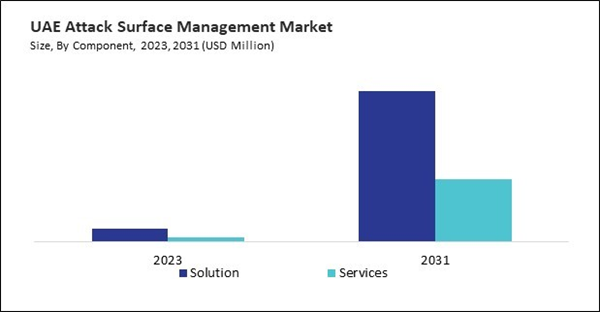The Brazil market dominated the LAMEA Attack Surface Management Market by Country in 2023, and would continue to be a dominant market till 2031; thereby, achieving a market value of $128.1 million by 2031. The Argentina market is experiencing a CAGR of 37.6% during (2024 - 2031). Additionally, The UAE market would exhibit a CAGR of 36.4% during (2024 - 2031).
As organizations embrace cloud computing, IoT devices, mobile applications, and other emerging technologies, the complexity and scale of their attack surfaces have grown, presenting new challenges for cybersecurity professionals tasked with safeguarding critical assets and data. In response to these evolving threats, the market has emerged as a critical component of modern cybersecurity strategies, offering organizations comprehensive visibility, assessment, and mitigation capabilities to protect against a wide range of cyber threats.
In addition, factors including the increasing frequency and sophistication of cyber-attacks, regulatory compliance requirements, and the growing awareness of cybersecurity risks among organizations of all sizes and industries have driven the adoption of attack surface management solutions. As high-profile data breaches and cyber-attacks dominate headlines, organizations are under mounting pressure to fortify their defenses and mitigate their exposure to cyber threats.
In addition, the growth of e-commerce in Brazil fosters the emergence of new online marketplaces and platforms. These platforms, often startups or smaller companies, may lack robust cybersecurity measures compared to established players, making them prime targets for cyber attacks. The growing complexity of the e-commerce ecosystem in Brazil, including multiple stakeholders such as retailers, payment processors, and logistics providers, creates numerous entry points for cyber attacks. It helps identify and secure these vulnerabilities across the e-commerce supply chain. As per the data from the International Trade Administration, Brazil, the largest economy in Latin America, is anticipated to surpass $200 billion in e-commerce by 2026, an increase of 14.3% annually. Hence, the proliferation of e-commerce in LAMEA will assist in the growth of the regional market.
Based on Deployment Mode, the market is segmented into Cloud, and On-premise. Based on Component, the market is segmented into Solution, and Services. Based on Enterprise Size, the market is segmented into Large Enterprise, and mall & Medium Enterprise. Based on Vertical, the market is segmented into BFSI, Healthcare, Government & Defense, IT & ITeS, Energy & Utilities, Retail & E-Commerce, and Others. Based on countries, the market is segmented into Brazil, Argentina, UAE, Saudi Arabia, South Africa, Nigeria, and Rest of LAMEA.
List of Key Companies Profiled
- Palo Alto Networks, Inc.
- IBM Corporation
- Microsoft Corporation
- Cisco Systems, Inc.
- Google LLC (Alphabet Inc.)
- Trend Micro, Inc.
- Qualys, Inc.
- Tenable Holdings, Inc.
- Crowdstrike Holdings, Inc.
- BitSight Technologies, Inc.
Market Report Segmentation
By Deployment Mode- Cloud
- On-premise
- Solution
- Services
- Large Enterprise
- Small & Medium Enterprise
- BFSI
- Healthcare
- Government & Defense
- IT & ITeS
- Energy & Utilities
- Retail & E-Commerce
- Others
- Brazil
- Argentina
- UAE
- Saudi Arabia
- South Africa
- Nigeria
- Rest of LAMEA
Table of Contents
Companies Mentioned
- Palo Alto Networks, Inc.
- IBM Corporation
- Microsoft Corporation
- Cisco Systems, Inc.
- Google LLC (Alphabet Inc.)
- Trend Micro, Inc.
- Qualys, Inc.
- Tenable Holdings, Inc.
- Crowdstrike Holdings, Inc.
- BitSight Technologies, Inc.
Methodology

LOADING...









